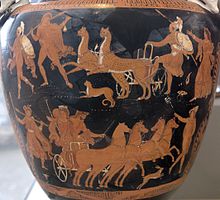***I think this looks like a dark faerie lord and a sweet young thing, but it's supposed to be Hades and Persephone. Oh, well... Here's a bit of their story...
The myth of a goddess being abducted and taken to the Underworld is probably Pre-Greek in origin. Samuel Noah Kramer, the renowned scholar of ancient Sumer, has posited that the Greek story of the abduction of Persephone may be derived from an ancient Sumerian story in which Ereshkigal, the ancient Sumerian goddess of the Underworld, is abducted by Kur, the primeval dragon of Sumerian mythology, and forced to become ruler of the Underworld against her own will.
The location of Persephone's abduction is different in each local cult. The Homeric Hymn to Demeter mentions the "plain of Nysa".The locations of this probably mythical place may simply be conventions to show that a magically distant chthonic land of myth was intended in the remote past. Demeter found and met her daughter in Eleusis, and this is the mythical disguise of what happened in the mysteries.[
Persephone is an old chthonic deity of the agricultural communities, who received the souls of the dead into the earth, and acquired powers over the fertility of the soil, over which she reigned. The earliest depiction of a goddess who may be identified with Persephone growing out of the ground, is on a plate from the Old-Palace period in Phaistos. The goddess has a vegetable-like appearance, and she is surrounded by dancing girls between blossoming flowers. A similar representation, where the goddess appears to come down from the sky, is depicted on the Minoan ring of Isopata.
In some forms Hades appears with his chthonic horses. The myth of the rape of Kore was derived from the idea that Hades catches the souls of the dead like his booty and then carries them with his horses into his kingdom. This idea is vague in Homer, but appears in later Greek depictions, and in Greek folklore. "Charos" appears with his horse and carries the dead into the underworld.
The cults of Persephone and Demeter in the Eleusinian mysteries and in the Thesmophoria were based on old agrarian cults. A lot of ancient beliefs were based on initiation into jealously-guarded mysteries (secret rites) because they offered prospects after death more enjoyable than the final end at the gloomy space of the Greek Hades. There is evidence that some practices were derived from the religious practices of the Mycenaean age. Kerenyi asserts that these religious practices were introduced from Minoan Crete. The idea of immortality which appears in the syncretistic religions of the Near East did not exist in the Eleusinian mysteries at the very beginning.



